March 31, 2011
It's All One Atmosphere
By: Aaron Datesman
This came across my desk today. It is a measurement of fallout from the Fukushima disaster – taken in upstate Illinois. You can see that, as of a few days ago, there are concentrations of radioactive Iodine-131 present in the atmosphere in Illinois at levels of ~0.02 picoCuries/cubic meter.
Similar information has been reported in the press, and I do not have very much to add which is directly relevant. I agree that the activity level is rather low, although I have problems with the implicit use of what I term the “isotropic hypothesis”. (This hypothesis is generally expressed as, “Dilution is the solution to pollution.” It ignores ecological and biological processes which re-aggregate dispersed materials, among other issues.)
If the I-131 released by the Fukushima disaster were distributed uniformly over just the Northern hemisphere of the earth at a concentration of 0.02 pCi/m^3, that would amount to 5000 Curies of activity per km of atmosphere in height. The jet stream is around 10km in altitude, so let’s call it 50,000Ci – the amount of radioactivity in 50kg (110 pounds) of Radium-226.
That’s a lot. But it’s actually much worse:
The French radiation protection authority, Institut de Radioprotection et de Sûreté Nucléaire (IRSN), estimates the radioactive releases of iodine-131 in Japan had reached about 2.4 million curies by March 22, 2011. That is about 160,000 times the best estimate of the amount released during the TMI accident in Pennsylvania (15 curies) and about 140,000 times the maximum estimate of 17 curies. It is about 10 percent of the estimated amount released during the Chernobyl accident, according to the IRSN.
140,000 times more! Well, OK – 140,000 x 0 = 0. Because we know that the accident at Three Mile Island didn’t harm anyone.
— Aaron Datesman
March 30, 2011
Everything Old Is New Again
By: John Caruso
American intelligence agents have admitted they helped to train the Kosovo Liberation Army before NATO's bombing of Yugoslavia. The disclosure angered some European diplomats, who said this had undermined moves for a political solution to the conflict between Serbs and Albanians. Central Intelligence Agency officers were ceasefire monitors in Kosovo in 1998 and 1999, developing ties with the KLA and giving American military training manuals and field advice on fighting the Yugoslav army and Serbian police.
When the Organisation for Security and Co-operation in Europe (OSCE), which co-ordinated the monitoring, left Kosovo a week before airstrikes began a year ago, many of its satellite telephones and global positioning systems were secretly handed to the KLA, ensuring that guerrilla commanders could stay in touch with NATO and Washington. Several KLA leaders had the mobile phone number of General Wesley Clark, the NATO commander.
Barack Obama signed a secret order authorising covert US government support for rebel forces seeking to oust Libyan leader Muammar Gaddafi, according to government officials.
Mr Obama reportedly signed the order, known as a presidential "finding", within the last two or three weeks, four US government sources told Reuters. [...]
The New York Times reported that the CIA has had clandestine operatives who have been gathering intelligence for air strikes and making contact with the rebels for several weeks.
As far as we know the Libyan resistance isn't basically an organized crime outfit led by a heroin dealer and human organ trafficker, though, so there are at least a few differences.
(That "two or three weeks" is very interesting, given that Security Council resolution 1973 was only passed 13 days ago.)
— John Caruso
March 29, 2011
More Joe Bageant
I found this here. There are also other people writing about Joe Bageant here and here.
—Jonathan Schwarz
You Couldn't Be More Wrong, Jodi!
Jodi Taylor of Gallipolis, Ohio has a high school education and a state job as a janitor, and, as you might expect, just isn't sophisticated enough to understand politics:
The Taylors are not college educated, but their public-sector jobs have made them middle class. Together they earn about $63,000 a year...“We’re not living in any rich, high-income way,” said Ms. Taylor, 37, who, together with her husband, protested the public-sector bill in Columbus this month.
“What are they wanting?” she said of the bill. “For everyone to be making minimum wage?”
Ha ha, what a stupid mistake! What "they are wanting" isn't for everyone to be making minimum wage. What they are wanting is for there not to be a minimum wage.
—Jonathan Schwarz
March 28, 2011
Joe Bageant
This was posted yesterday, so he died on Saturday:
After a vibrant life, Joe Bageant died yesterday following a four-month struggle with cancer. He was 64. Joe is survived by his wife, Barbara, his three children, Timothy, Patrick and Elizabeth, and thousands of friends and admirers. He is also survived by his work and ideas.According to Joe's wishes, he will be cremated. His family will hold a private memorial service.
Some of my favorite writing by Joe Bageant:
"What the 'Left Behind' Series Really Means"
His photoalbum of his hometown of Winchester, Virginia
Now that it's too late for the money to do him any good, I just bought Rainbow Pie: A Redneck Memoir and Deer Hunting with Jesus.
And here's that great interview with him from last year (thanks, Nell). He says this at the end:
The struggle is for the consciousness of the planet, the consciousness of that smear of biology on a speck of cosmic dust. There's a spiritual side of man, there's a moral side. I'm not a Christian, but it's there, and it's there for us to share as a people, together.
—Jonathan Schwarz
March 27, 2011
Our Many Devious Enemies
I don't know about you, but to me this indicates that the Libyans, Afghans and Vietnamese have all gone to some central training school to learn how to undermine us most effectively.
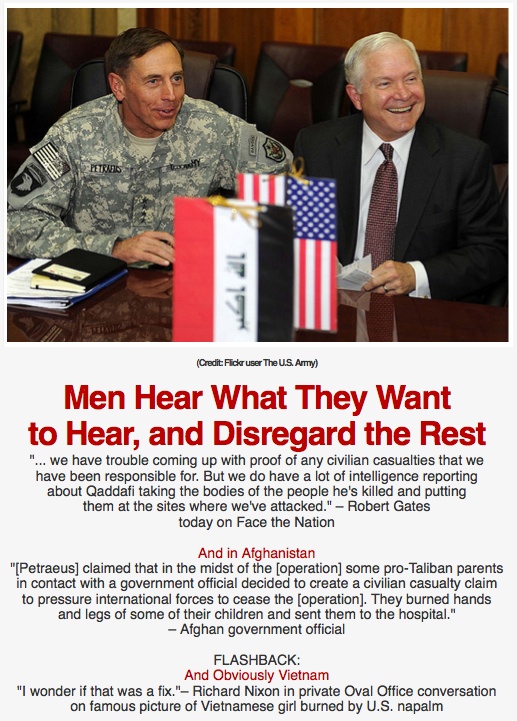
—Jonathan Schwarz
Expanded Memory Hole Now Accepting Cabinet Secretaries
By: Aaron Datesman
My personal heroes include Saul Alinsky, Kurt Vonnegut, and David Dellinger, which only indicates my conclusion that “troublemaker” is just a way of saying “saint” with more syllables. Among the other Americans on the list, there is a woman, too. I believe that no human being ever did more to improve the lives of Americans than she did(*). Because of this, I doubt that one American out of one hundred has ever heard of her.
Her name is Frances Perkins. That’s her in the black coat and hat in the middle panel below.
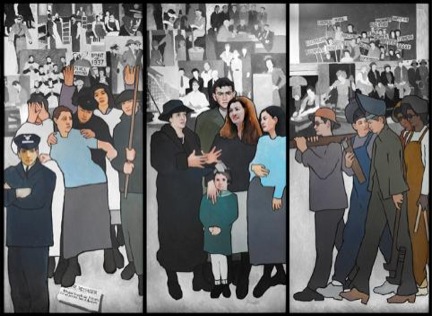
If you’ve been following the news, you might recognize these panels as belonging to the labor history mural which the governor of Maine is trying to remove (perhaps he has succeeded by this time) from the state labor department. I’m sure that removing images of Frances Perkins from the public domain has nothing to do with, oh, attacks on public sector unions or Social Security.
It’s an especially classy touch, I think, that the attempt in Maine (the site of Perkin’s grave) to toss this one small remaining shred of our shared history into the Memory Hole comes on the centennial of the Triangle Shirtwaist Fire. Perkins witnessed that tragedy in 1911. According to her biographer, it was a turning point in her life.
(*) P.S. The biography of Perkins by Kirstin Downey, The Woman Behind the New Deal: the Life and Legacy of Frances Perkins, is one of the most exceptional books I have ever read. The following excerpt from the book’s prologue describes her interview with Franklin Roosevelt for the position of Secretary of Labor - a position which she held for twelve years. It’s a bit dramatized, I think, but it supports my opinion that no other single person ever did more to improve the health, safety, welfare, and quality of life of her fellow Americans.
He wanted her to take an assignment but she had decided she wouldn’t accept it unless he allowed her to do it her own way. She held up the piece of paper in her hand, and he motioned for her to continue.She ticked off the items: a forty-hour workweek, a minimum wage, worker’s compensation, unemployment compensation, a federal law banning child labor, direct federal aid for unemployment relief, Social Security, a revitalized public employment service, and health insurance.
— Aaron Datesman
March 24, 2011
A Geographical Note About the Infant Death Rate at TMI
By: Aaron Datesman
You may be aware of the London Big Smoke, which killed about 12,000 people in 1952. It was caused by a temperature inversion: a layer of cold, stagnant air trapped under a lid of warm air. This phenomenon can temporarily halt convective transport in the atmosphere locally: that is, it prevents the atmosphere from mixing (and prevents dispersion of pollutants). The mechanics are similar to the considerations Thomas Jefferson made for siting Monticello, which I mentioned in comments here. Wikipedia has a nice picture of the effects of a temperature inversion over a factory in Scotland, below. Note how the factory effluent fails to cross the boundary between the cold, dense layer near the ground and the warmer cap above.
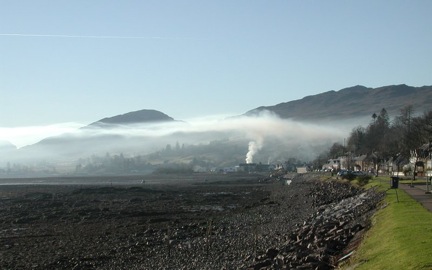
Generally the atmosphere is warmer closer to the earth, since air is transparent to sunlight and warmed from below. The temperature of the air is a balancing act between the energy incident from the sun and the thermal energy radiated by the earth. Although temperature inversions don’t ordinarily kill thousands of people, they are common. They are most common a) at night, and b) in winter, when the sun provides a lower density of incident energy.
An event similar to the Big Smoke occurred in Donora, PA, on October 27, 1948. The Donora Smog killed 20 people and 800 animals, and was one of the precipitating events leading to passage of the Clean Air Act in 1970. Donora is in the Monongahela River Valley south of Pittsburgh. I worked in nearby Charleroi, PA for a while in 2006. This is a topographic map of the Mon Valley around Donora. You will certainly notice the hills on both sides of the river, with Donora tucked into a flat spot on the west bank. That a strong temperature inversion would occur in this terrain is hardly surprising. In fact, I suspect that at least mild inversions are probably common in the Mon Valley at night in fall and winter, since cold, dense air will slide off of the hills and down into the trough of the river, displacing warm air.
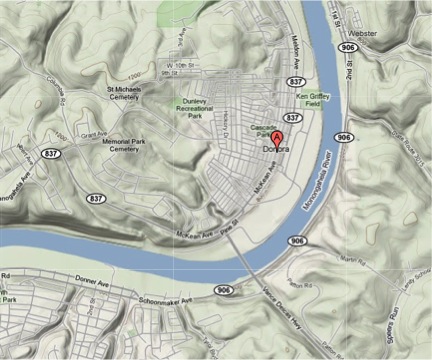
This is a topographic map of the area around Three Mile Island and Harrisburg, PA. Three Mile Island is in the lower right, on the island labeled “Susquehanna River”. It is somewhat more hilly in the Mon Valley than around Harrisburg, but the difference is accentuated because the scales on the maps are different. It’s pretty hilly in the Susquehanna Valley around Harrisburg, too.

Therefore, I have a reasonable suspicion that temperature inversions frequently occur on the river on cold fall and winter days (and at night) in the area around Harrisburg. (I think Thomas Jefferson, who knew a few things, would back me up on this.) This would prevent emissions (including permitted emissions of radioactive gases – yes, there are such things, and quite a lot of them actually) from the reactors at Three Mile Island from dispersing to the wider atmosphere, as shown with the smoke in the picture from Scotland above.
Instead, fallout (I fail to see the difference between fallout and “emissions”) would most likely settle in the immediate vicinity of TMI. Depending on the exact characteristics of the warm cap layer in the inversion, the flat plain on which Harrisburg sits is a very likely destination.
This is the infant death rate data from Wasserman and Solomon quoted in an earlier post. The interesting question is, do the high infant mortality rates in Harrisburg in fall and winter really have a sociological explanation? I find it disturbing that there’s not a corresponding trend in the state-level data. (The rate does dip a bit in the summer.)

A plausible hypothesis, it seems to me, is that this data covers information from two discrete sets of fallout events. The first is the accident at TMI-2, in spring 1979. The second set of fallout events correspond to routine emissions from TMI-1, trapped along the river by atmospheric inversion layers and deposited in Harrisburg as fallout. This hypothesis explains the puzzling seasonal variation. TMI-1, which appears to have had an excellent official safety record, opened in 1974.
This is from the prologue to the Marie Holowka interview in the TMIA archives:
The Holowka’s have had many animal problems on their farm since the time TMI began operation in 1974.
The hypothesis is testable, of course: it could easily be disproved using data like that in the chart from the years before 1974. I do not have that data, and so I don’t even intend to offer the hypothesis (although I know that I stated it). Instead, I wrote this post to show how complicated the analysis of emissions and fallout really ought to be. Therefore, when I read statements like that from Dr. Kemper that fission byproducts are light and disperse harmlessly into the atmosphere, I engage in the short daydream that there is a licensing board for physicists, and that I can slap the speaker, and take away his right to integrate.
We would never allow this technology to exist if we really understood all of the complications which necessarily follow, but are never considered.
— Aaron Datesman
March 22, 2011
Infants Died at TMI
By: Aaron Datesman
I have stolen the title of this post from Harvey Wasserman and Norman Solomon’s excellent book, Killing Our Own. I am about to steal their data, too.
Before I engage in this theft, however, I would like to explain again why this historical topic engages my interest at a time when an incredible disaster is unfolding in Japan. Because the historical consensus is that nobody died from the TMI accident, and that as a consequence it wasn’t really a big deal, in my opinion we are failing to understand what the median health effects will be for the population of Japan due to the much larger disaster unfolding there.
TMI killed a lot of people, some miles or some years down the road, and caused increased illness and poor health for many tens or hundreds of thousands more. But in the natural variability of living, health, and time, that signal is difficult to discern. (It scarcely helps that we generally refuse to look for it.) Perhaps this fact indicates that the harm from nuclear power, partial meltdowns and all, is preferable to the harms we also suffer due to other technological choices we make, such as burning coal. George Monbiot makes that argument here. I may have a comment on that idea once I finish what I have to say about the health effects of the TMI accident. I think it’s interesting; but for now, it doesn’t engage me.
This is the data on the infant death rate in the area surrounding Three Mile Island compiled by Wasserman and Solomon from the records of the Pennsylvania Department of Health. The PA State Capitol Building in Harrisburg is a bit more than ten miles north (and a bit west) of Three Mile Island, right along the Susquehanna River. The accident at TMI-2 took place at the end of March, 1979, at the very end of the Winter 1979 time period displayed in the chart. Therefore the Spring 1979 row covers the first months after the accident.

It is difficult to make heads or tails of this data. The sample size is not very large, for one thing. In 1980, the population of Harrisburg was only 53,000, so there are probably in the neighborhood of 300-500 births represented in each quarter. (It is possibly 2-5x more. I don’t know how many people lived inside of the ten-mile radius but not in Harrisburg.) Therefore, it is difficult to view the statistics as robust. Additionally, there is a strong seasonal variation to the death rate in Harrisburg, which confounds interpretation of the data.
However, there is at least one clear signal in the data presented. In Spring 1979, immediately following the TMI accident, the infant death rate in Harrisburg was 29.7 per 1000 live births. In the comparable period from 1978, it was 11.5 per 1000; and 8.1 per 1000 in 1977.
The infant mortality statistics refer to deaths in the first year of life. Neonatal mortality is a subset of infant mortality, referring to deaths in the first month of life. This chart provides the neonatal mortality statistics.

You will note the number in the Spring, 1979 line in Harrisburg: 29.7 per 1000. It is identical to the infant death rate. Wasserman and Solomon explain why this is:
And in those tragic three months after the TMI accident every Harrisburg baby listed as an infant-mortality statistic had in fact died in the first twenty-eight days of life.
What would the results of fallout from a severe nuclear accident descending upon a moderate-sized American city actually be? Dead babies seem a likely one. If you can detach yourself from the conventional wisdom that there were no ill effects due to the accident at Three Mile Island, I think the data show rather clearly that there was a radiological disaster in Harrisburg in the spring of 1979.
If you have ever been to Harrisburg - especially if you’ve driven through - you might note that the Susquehanna bridges are pretty high. With a topographic map, I think one might predict that the likeliest place for TMI fallout to land is also the regional population center just upriver. But to make this connection one must first embrace the basic reality that emissions from nuclear power plants are not magically and immediately diluted in the full volume of the atmosphere once they leave the vent stack at the plant. Unfortunately, this is a reality that many nuclear experts have yet to embrace.
Perhaps no one died as a result of the accident at Three Mile Island. For myself, I think we would come to another conclusion altogether if we really opened our eyes and took the time to look.
— Aaron Datesman
March 21, 2011
Oh Dear Lord, Help Us All
By: Aaron Datesman
Ordinarily, it would be beneath me to comment on an article (“Damaged Nuclear Power Plants Could Spew Range of Emissions”, March 14, 2011) from the Wall Street Journal. But I read this by accident, and would like to use it to make an unfortunate point.
In a total meltdown, several radioactive gases are released on the less-toxic end of the spectrum, including nitrogen-16, tritium and krypton. Each of these gases is light and tends to dissipate quickly, posing little danger to humans, said Kirby Kemper, a nuclear physicist at Florida State University.Nitrogen-16 decays quickly and becomes stable oxygen. Krypton gas also is very light and would get released into the atmosphere and dissipate quickly.
Kirby Kemper is a Fellow of the American Physical Society, which is a big deal, and the Vice President for Research at FSU. I am not smart enough to ever become either of those things. Do I really need to say that, apparently, Kirby Kemper, Ph.D., is also a very, very big moron?
The molecular weight of krypton is around 84 g/mol; the molecular weight of air, which is mostly nitrogen, is around 28 g/mol. It is not very light by any justifiable standard, and the statement that it will “dissipate quickly” perhaps is only true if you open a cylinder of it while standing on the peaked roof of your house.
It’s possible, of course, that I’m being unfair to Prof. Kemper (who has 262 professional publications on his CV). Maybe the reporter just got it wrong – in which case, it’s a nice touch to get it wrong twice. It is terrifying enough, I think, that our news media is so incompetent regarding an issue which quite literally straddles the line between living and dying for many or all of us.
However, it’s also possible that, after a successful career spent in the field of nuclear engineering, certain opinions become established as fact by way of repetition and groupthink which simply ARE. NOT. SO. (I wrote about this topic here.) For instance, while I have been aware for many years that radioactive noble gases are released by operating nuclear reactors and by reprocessing of nuclear fuel, until I began to dig into this topic last week it literally never occurred to me that krypton and neon are not, in fact, buoyant in air. This is a significant act of brainwashing, I think.
For this reason, I’m afraid that the situation is even more dire than it might appear to be. The media, of course, are totally worthless on the topic of the dangers of radiation and radioactive fallout, as they are useless on almost any substantial topic. This is bad enough on its own. However, the experts who do exist, the ranks of scientific experts in nuclear technology and nuclear engineering, in many cases appear to have been captured by the relentless brainwashing about the safety of nuclear technology that our society has endured for decades.
It would seem that we can’t count on technical experts to apply commonsense knowledge they learned in high school to the industry about which we trust them to advise us. Oh Dear Lord Help Us All.
UPDATE: Thanks to a reader for pointing out an error in this post. Neon is, in fact, lighter than air. I meant, "krypton and xenon", both of which are noble gases, heavier than air, and fission products. Sorry about that.
For the physics-inclined, it turns out that it's not hard to test the assertion made in this post against some numbers. The proper framework is given by the Chapman-Enskog Theory, which is derived from the Boltzmann transport equations.
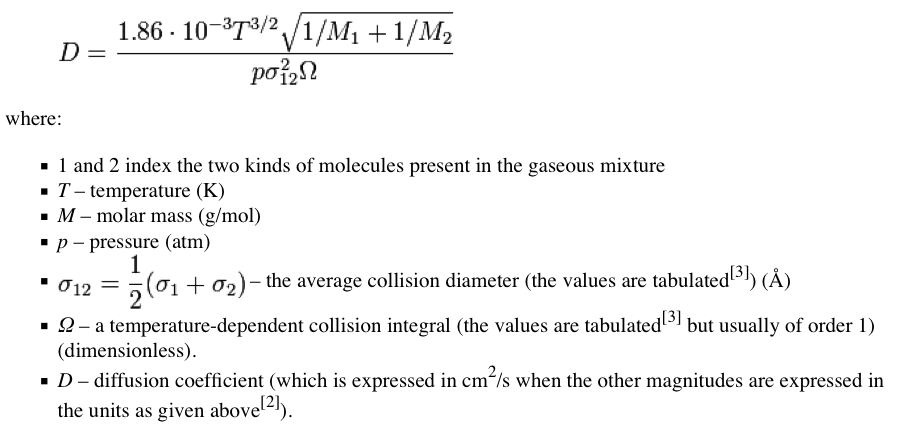
For carbon dioxide (CO2) diffusing in air, the diffusivity coefficient D=16 mm^2/sec. I don't have access to a table which would let me calculate the value exactly, but examining the formula it's clear that the diffusivity of Kr in air can not be much different than that of carbon dioxide. It follows from this that the characteristic diffusion length over a one hour time span is 480 mm - less than two feet. This is basic undergraduate physics.
It's a bit complicated to explain exactly what the characteristic diffusion length is, but it's basically this: take a huge weather balloon on smooth, flat ground, filled with krypton. At time t=-20 seconds, I dissolve the balloon in acid. (This is chosen as the time origin since there is an abrupt discontinuity when the balloon disappears.) At t=0 seconds, I will obviously have a big, round cloud of krypton which has started to blur around its edges, so it's a bit bigger than the balloon.
After one hour, in the absence of wind, that cloud of krypton will be about 960mm larger in diameter. I would not characterize that cloud as dispersing quickly.
— Aaron Datesman
The Lesson the U.S. Is Teaching the World in Libya
In all the discussion about the current U.S. bombing of Libya, something important has gone almost unnoticed—the lesson the United States is teaching the government of every country on earth. That lesson is: no matter what, no matter the inducements or pressure, never ever give up chemical weapons or a nuclear weapons program. Doing so will not ensure that the U.S. does not attack you—on the contrary, it will make it much more likely.
The U.S. already delivered this lesson very powerfully in 2003 by attacking Iraq, a country which had no biological or chemical weapons or nuclear weapons program after 1991, twelve years earlier. Moreover, according to the CIA's 2004 WMD report, Saddam Hussein had begged the Clinton administration for better relations, promising that it would be Washington’s “best friend in the region bar none.” In fact, Iraq said that if it had a security relationship with the U.S., it would be inclined to permanently discard even the ambition for WMD.
In Libya's case, Moammar Gaddafi announced in December, 2003 that it was renouncing all WMD—Libya possessed chemical weapons, ballistic missiles and a nuclear weapons program—and inviting international inspectors to certify its compliance. The U.S. declared that this "demonstrates that, in a world of strong nonproliferation norms, it is never too late to make the decision to become a fully compliant NPT state," and that Libya would be "amply rewarded." From the perspective of many governments, Libya is now receiving its reward, in the form of hundreds of Tomahawk missiles and the likely downfall of the regime that agreed to disarm.
Every government on earth has different factions with different views of the best strategy to deal with the world, factions that constantly battle each other for supremacy. Whether or not Iran has an active nuclear weapons program (it's still the official position of the U.S. intelligence community that it does not) we can be sure the Iranian faction that wants nuclear weapons has been tremendously strengthened by the attack on Libya. And the faction that believes Iran would be safer without nuclear weapons is much weaker, and in fact is probably being ridiculed for its embarrassing naiveté.
Something similar is going on inside the North Korean government. Anyone within the regime who's been pressing for North Korea to give up its nuclear weapons is now in a much worse position.
But here's what no Americans know: the current attack on Libya is not an unforeseen glitch in our efforts to get them to disarm. Instead, it was the explicit policy of the U.S. to get countries to disarm so that we would be able to attack them.
This may sound ridiculous to many Americans. After all, no president ever puts it like that. Instead, they say: our enemies must disarm because they threaten the precious lives of our citizens! But in fact when talking to each other, U.S. government officials say it over and over again: we don't oppose countries like Iraq, Libya and Iran having WMD because we're scared they're going to attack us with them. Instead, we oppose them having WMD because that would allow them to deter us from attacking them.
For instance, here's a little-noticed January, 2001 memo by Donald Rumseld just after he became Secretary of Defense:
Several of these [small enemy nations] are intensely hostile to the United States and are arming to deter us from bringing our conventional or nuclear power to bear in a regional crisis...[U]niversally available [WMD] technologies can be used to create "asymmetric" responses that cannot defeat our forces, but can deny access to critical areas in Europe, the Middle East, and Asia..."asymmetric" approaches can limit our ability to apply military power.
And here's a September, 2002 speech by Philip Zelikow, executive director of the 9/11 Commission and author of the 2002 National Security Strategy, about the threat posed by Iraq. The threat was not that Iraq would attack us, but that WMD would make it possible for someone to deter us (and Israel):
I criticise the [Bush] administration a little, because the argument that they make over and over again is that this is about a threat to the United States...
Now, if the danger [from Iraq] is a biological weapon handed to Hamas, then what’s the American alternative then? ... they now can deter us from attacking them, because they really can retaliate against us, by then.
This point was made over and over again in "Rebuilding America's Defenses," the infamous paper from Project for a New American Century. Page 6:
...the United States also must counteract the effects of the proliferation of ballistic missiles and weapons of mass destruction that may soon allow lesser states to deter U.S. military action by threatening U.S. allies and the American homeland itself. Of all the new and current missions for U.S. armed forces, this must have priority.
Page 51:
When their missiles are tipped with warheads carrying nuclear, biological, or chemical weapons, even weak regional powers have a credible deterrent regardless of the balance of conventional forces.
Page 54:
In the post-Cold War era, America and its allies, rather than the Soviet Union, have become the primary objects of deterrence and it is states like Iraq, Iran and North Korea who most wish to develop deterrent capabilities.
In 2008, former senators Daniel Coats and Chuck Robb explained the problem in the Washington Post:
...Iran would not need to employ a nuclear arsenal to threaten U.S. interests.Simply obtaining the ability to quickly assemble a nuclear weapon would effectively give Iran a nuclear deterrent...
And lead author of "Rebuilding America's Defenses," Thomas Donnelly—a longtime member of the U.S. foreign policy establishment now working at the American Enterprise Institute—also wrote a paper called "Strategy for a Nuclear Iran":
The surest deterrent to American action is a functioning nuclear arsenal...
To be sure, the prospect of a nuclear Iran is a nightmare. But it is less a nightmare because of [a] high likelihood that Tehran would employ its weapons or pass them on to terrorist groups—although that is not beyond the realm of possibility—and more because of the constraining effect it threatens to impose upon U.S. strategy for the greater Middle East.
That's why we pressed Libya to disarm—not because of a threat to U.S. citizens, but because of the threat of a "constraining effect...upon U.S. strategy for the greater Middle East." And it worked: right now we can implement our strategy with far fewer worries.
So that's the lesson the Obama administration is teaching the world: listen to what U.S. officials say about their plans, and take it very, very seriously. Don't make the mistake that Iraq and Libya made and disarm—it's not a path to safety. Instead, it's the quickest route to your own destruction.
—Jonathan Schwarz
March 20, 2011
U.S. Launches $157 Million Worth of Democracy at Libya
By: John Caruso
Citizens of Raytheon are united in joy!
"I've authorized* the Armed Forces of the United States to begin a limited military action in Libya," Obama said during a visit to Brazil. "That action has now begun."
Admiral William Gortney told reporters in Washington that US ships and one British submarine fired 110-112 [Tomahawk] cruise missiles at air defence targets including in cities of Tripoli and Misrata.
* (I wonder if the Constitutional scholar-in-chief thinks that Article I, Section 8, Clause 11 feels smoother than Article I, Section 9, Clause 2 when he wipes his ass with it?)
For those keeping score, the U.S. is currently waging war at varying levels in Afghanistan, Pakistan, Iraq, Libya, and Yemen. Which might seem discouraging, but on the other hand, just imagine how many countries we'd be bombing right now if we didn't have an anti-war Democrat in the White House.
WHERE CREDIT IS DUE: It's good to see Dennis Kucinich asking the right question:
A hard-core group of liberal House Democrats is questioning the constitutionality of U.S. missile strikes against Libya, with one lawmaker raising the prospect of impeachment during a Democratic Caucus conference call on Saturday. [...] Kucinich, who wanted to bring impeachment articles against both former President George W. Bush and Vice President Dick Cheney over Iraq — only to be blocked by his own leadership — asked why the U.S. missile strikes aren’t impeachable offenses.
They are, of course. And Obama didn't ask for a Congressional resolution—which I don't doubt he could easily have gotten—for the same reason the Clinton administration refused to seek the required U.N. Security Council authorization for its attack on Yugoslavia:
French officials said the deployment of NATO peacekeepers in Kosovo needed to be backed by a United Nations Security Council resolution, a proposition that the Clinton Administration opposed. Washington, according to State Department officials, was sticking to its stand that NATO should be able to act independently of the United Nations.
The debate played out in Paris, Rambouillet, London and Washington with a compromise worked out this afternoon by the British. Instead of the United Nations being asked to ''authorize'' the deployment, the Security Council will be asked to ''endorse'' it, a British diplomat said.
In this way, all sides could claim victory. For the French, the United Nations still got a nod. For the Americans the ''neuralgic word 'authorize,' '' was avoided, the diplomat said.
— John Caruso
March 17, 2011
What Killed Marie Holowka
By: Aaron Datesman
This post relates to the story about Marie Holowka, which I wrote about here. I would like to be clear about why I’ve chosen this story to focus on. I’m not choosing to write about this one peripheral topic because I find it technically engaging. The woman died, for chrissakes. Our ability to use undergraduate physics to explain what killed her is not important.
It’s important because her story is SO GODDAMN TERRIFYING that most people who read it find it impossible to believe. Because I can apply physical law to explain it, however, I believe it to be true – and I want you to understand why you should believe it as well.
If I had followed the career path I seemed to be on at the time, as a university professor I could assign the following problem to a group of not-very-eager undergraduates:
A bottle of compressed gas is vented to atmosphere at a pressure of 150 psi. The molecular weight of the gas is 84 g/mol. If there is gentle, laminar airflow from the northeast at a speed of 2 m/s and neglecting boundary layers, give a qualitative estimate of where this cloud of heavier-than-air gas will settle.
It’s a reasonably hard problem, as it happens; I doubt that there is an analytical answer. I could make some basic arguments using the kinetic theory of gases to arrive at an envelope-back answer, which may or may not be correct. Alternatively, one could try to arrive at an answer using partial differential equations and the diffusion equation. Such things are done to analyze the deposition of smokestack pollution, for instance.
At any rate, this is perfectly ordinary and boring, and it’s obvious that the gas will settle out eventually somewhere sometime later. It’s much heavier than air, after all, since the nitrogen molecule (air is mostly nitrogen) has a mass of only 28 g/mol. It’s also pretty intuitive that, if it settles reasonably quickly, it also won’t disperse very much. I will return to this thread in a moment.
In the previous post, I argued that interactions between gamma rays and nitrogen atoms (bound up in nitrogen molecules) in the air caused the blue glow which Marie Holowka observed. I maintain that this is correct. There’s even a phrase which describes the physical process exactly: gamma ray photoionization. I used the journal access I enjoy at my job to look up a couple of papers on this topic today. One is called “Ionization of Air by Gamma Rays as a Function of Pressure and Collecting Field”. It was published in the Physical Review on July 1, 1932.
The date on that article indicates quite well, I think, that I’ve proposed nothing radical by noting that a gamma ray photon can strip an electron from a molecule of nitrogen in our atmosphere. I have also proposed nothing radical by noting that free electrons in an ionized gas emit light when the electrons and ions again recombine. If you learned about the Lyman, Balmer, and Paschen series in high school, this is what you were learning about. In my scientific career, I have observed these recombinations in blue plasmas of nitrogen I have made dozens of times – in vacuum systems used for semiconductor processing. This is perfectly ordinary, pedestrian, undergraduate-level physics.
The second article I downloaded is titled “Single- and double-photoionization cross sections of atomic nitrogen from threshold to 31 Ang.” It was published in Physical Review A in 1990. The article contains the graph below, which basically shows the likelihood that a gamma ray photon will ionize an atom of nitrogen. The details are not important, although I will note a) that a Megabarn (Mb) is a really big cross-section, and b) that the higher the photon energy, the lower the probability that it will interact.

At higher photon energies, the trend is the same in all materials. For instance, the graph below shows the X-ray (there is no real physical distinction between X-rays and gamma rays) mass attenuation coefficient for human tissue. The data comes from the National Institute of Standards and Technology, NIST. This sounds complicated, but basically the graph shows how likely the energy in a gamma ray is to be absorbed by human tissue, rather than passing straight through. You can see that, above around 30keV, human tissue becomes somewhat transparent to gamma rays.

Quite frankly, I was not aware of this fact before I began trying to untangle this puzzle.
I also argued in the previous post that Holowka (and others in the area around TMI at the time) felt hot because they were bombarded by gamma rays, which deposited energy in their skin. I no longer believe that this is the correct explanation (although bombardment with lower-energy gamma rays will create a sensation of warmth), and I would like to retract it. There is an explanation which fits the facts much more completely. That explanation is coming.
Having laid all of this out, I still had some trouble believing in this explanation because I have never encountered separate anecdotal evidence about atmospheric photoionization from radioactive materials. It turns out that there is a rather famous story which fits the bill, however: Louis Slotin, the Los Alamos physicist who died of radiation poisoning in 1946 after a criticality accident.
At 3:20 p.m., the screwdriver slipped and the upper beryllium hemisphere fell, causing a "prompt critical" reaction and a burst of hard radiation. At the time, the scientists in the room observed the "blue glow" of air ionization and felt a "heat wave". In addition, Slotin experienced a sour taste in his mouth and an intense burning sensation in his left hand.
(If you read through the TMIA archives again, you’ll note that many people reported a dull, metallic taste in their mouths during the accident, just as Slotin is reported to have tasted.)
The nature of the events at Los Alamos and at the Holowka farm are totally distinct. There were 6.5kg of plutonium shaped into a bomb core present at Los Alamos, which briefly underwent a self-sustaining fission chain reaction. Nothing similar was present at Marie Holowka’s home. Therefore the fact that Slotin succumbed to radiation poisoning after a few days due to a brief, intense dose, while Holowka survived for several years after the TMI accident despite a radiation exposure lasting for several days, does not at all allow one to conclude that gamma ray photoionization could not have been present in Pennsylvania in 1979.
To recap, there are two pieces here: a) the blue glow due to gamma ray photoionization, and b) the sensation of heat, which would not seem to be due to energetic gamma radiation. Actually, there is a third piece also: c) asphyxiation.
So I walked out and I’m going to the house. There’s a stone walk there. And I fell down, see. But I was scared and I thought, “Well, maybe I stumbled.” And I went about twenty feet away from the milk house. That poison gas must have hit me. I tumbled. And then I finally got myself up and I’m goin’ in. And I went about forty feet more, and I fell down again. And I said to myself, “Well, this must be poison gas, because I know I didn’t stumble. I just collapsed.” And I couldn’t get up. I’d try to get up and I couldn’t get up. I couldn’t get no strength to get up. I finally got myself up, and I went towards where those flowers are. Then I fell down [again]. And I said, “Oh, my. Now I really know something happened at Three Mile Island! It must be poison gas.” I just fell down. I had no strength to get up. I said, “Must I really die at Three Mile Island?” And I stayed there and I struggled. Nobody came out of the house to see me or nothing. So, I finally got up after struggling there maybe five minutes or so. I walked to the house. I opened the door. I stumbled into the house. I said to them, “Did you hear anything about Three Mile Island?” They said, “No, we didn’t.” I said, “You know what happened to me. I fell down three times before I could come to the house.” I was just something like a drunk.
Those three pieces fit together very completely, as it happens. It’s well known that the reactor at Three Mile Island vented large quantities of the radioactive gas Krypton-85. (Accounts of the accident generally refer to emissions of radioactive krypton and xenon as “noble gases”, which is technically correct but clearly intended as false assurance.) For instance, the reactor operators were given permission by the government to vent large amounts (43,000 Curies, officially) of Kr-85 to the atmosphere in July, 1980, more than a year after the accident.
This is from the TMIA testimony of Betty Farber:
Usually when they would vent, and had publicized that they vented, I would get the burning. It was all the time. The first year, they would say that they were just going to vent a little bit, in certain hours and so forth. And then sometimes they didn’t announce that they were venting and I’d be in the bathroom washing my face with cold water. I’d say to my husband, “Boy, I bet they vented today.” There were lots of times, maybe forty times that they didn’t announce it [beforehand]. And after that you’d find out that they did vent that day. Eventually it comes out. You know, someone finds it out and then they admit that they had released a little bit for so many minutes or [whatever].
Krypton-85 is a beta emitter, which means that it ejects a very energetic electron (~300keV on average) from the nucleus when it decays. A small percentage (0.4%) of the decays involve emission of a gamma ray with an energy of 514keV. Therefore, gamma rays are present in a cloud of radioactive Kr-85, but they are not dominant. Most of the decay energy is carried in beta particles. The half-life of Kr-85 is about ten years.
(As a side note, a gamma ray with an energy of 514keV has a path length in human flesh of around 10cm. Therefore, human flesh is not exactly transparent to a 514keV gamma ray, but many gamma rays with this energy will pass completely through a human without depositing all of their energy in flesh.)
I hope you see now how this post ties together. I asked my hypothetical undergraduates to analyze an accident at a nuclear plant which resulted in the release of radioactive Kr-85. Reading the interview again and looking at the accident history, I believe that the Three Mile Island disaster discharged a cloud of radioactive krypton gas, which (because it’s much heavier than air) settled on the Holowka farm seven miles away. As it settled to earth, this cloud of gas nearly asphyxiated Marie Holowka as she tried to walk from her barn to her home.
The heat which Marie Holowka spoke about was the result of beta particle irradiation; and the blue glow she reported was the result of gamma ray photoionization, exactly as had happened at Los Alamos in 1946. It took several days for the cloud of radioactive krypton to dissipate due to the movement of air.
If I were a radiochemist or a radiological epidemiologist, I would compose a fancy research grant proposal to investigate the presence of daughter radionuclides at the former Holowka family farm in Central Pennsylvania. This grant proposal would be summarily denied, of course, since everybody knows that there were no adverse health effects from the Three Mile Island accident. Marie Holowka, for instance, suffered horribly from cancer for many years, but isn’t counted on any list of TMI casualties. Officially, that list contains zero members.
I apologize for the length and for the advanced technical content of this post. Since some of the readers of this web site have better technical knowledge than I, and I already got it somewhat wrong the first time, I decided to be as complete as possible and as detailed as necessary.
Credit to Donald Johnson for pushing back on the previous post, which forced me to really think it through and come up with an explanation I feel is totally solid. I appreciate all of the readers and all of the comments; however, this wrings me out, and I need to take a break for a few days. Thank all of you for reading. If you agree that this is an important contribution to the discussion about nuclear energy, please distribute it as widely as you can.
— Aaron Datesman
The Stupidest Thing About NPR's Ron Schiller and Betsy Liley
It's hard to defend NPR when they're accused of being cowardly liberal elites who have contempt for most Americans, because they actually are cowardly liberal elites who have contempt for most Americans. Of course, it's a specific genre of liberalism—the Robert McNamara kind, the kind that involves being CEO of Ford and then dumping millions of pounds of napalm on Vietnamese eight-year-olds.
Anyway, it's tough to get worked up about the James O'Keefe NPR video and the ensuing groveling and bootlicking by NPR. Still, there's a part of the video that's very funny and hasn't gotten the right kind of attention:
PRETEND ISLAMIST DONOR #1: Certainly the Zionists and the people who have the interests in swaying coverage toward a favorable opinion of Israel...[since] NPR is one of the few places that has the courage to really present [the Palestinian viewpoint]. There's a kind of a joke—we used to call it National Palestinian Radio.RON SCHILLER: [laughs]
BETSY LILEY: Is that right? That's good! I like that!
(You can jump right to this section of the video here.)
How on earth did that not set off GIANT CLANGING ALARM BELLS for the NPR execs? Calling NPR "National Palestinian Radio" is a registered trademark of America's violent right-wing morons. Moreover, that kind of thing is a trademark of violent right-wing morons everywhere—violent right-wing Iraqi morons used to say the satellite channel Al Arabiya ("the Arab") should be called "The Hebrew," and back when Andrew Sullivan was in love with the invasion of Iraq he would talk about how the BBC should be called the "Baghdad Broadcasting Company."
Beyond that, I love the idea of NPR executives imagining Palestinians sitting around listening to NPR and thinking, "At least there's ONE U.S. news outlet that's on our side!" Likewise, I'm sure there were many New York Times editors in 1965 who got moist-eyed thinking of how the Negroes must appreciate having a newspaper that truly cared about them.
—Jonathan Schwarz
March 16, 2011
Is the AIR Supposed to be Blue?
By: Aaron Datesman
The archive at Three Mile Island Alert (TMIA) is an invaluable resource. When I first read the stories in the archive, I thought, “How can it be that this never made it into a newspaper anyplace? How can this possibly be new to me?” Certainly, the explanation must involve failures on the part of government and the media, as well as corporate malfeasance. But there’s an additional fundamental factor: we have very limited information about the weather. Consider our inability to forecast the weather very well, and you will begin to understand the scope of this restraint.
Radioactive materials released to the atmosphere during the partial meltdown at TMI could have landed as fallout basically….anywhere. For instance, it’s widely understood that the fallout from Chernobyl covers the entire Northern hemisphere. In a subsequent post, I’ll explain how the cloud of fallout from TMI was tracked from its source in central Pennsylvania, past Albany, NY, and all the way to Portland, ME.
When you further consider that the weather varies a lot on geographically small scales – have you ever watched it rain on the other side of the street? – you begin to understand that it’s quite hard (unless the accident is a total catastrophe, as Chernobyl was) to identify regions affected by fallout, especially some time after the event.
As pattern-seeking, reasoning creatures, we’re not well-equipped to understand a situation like this. When the residents of one farm some distance away from the reactor complained about dead animals and a metallic taste in their mouths persisting for days, while neighbors down the road but closer to the reactor site were fine, hysteria probably seemed a likelier explanation than nuclear catastrophe. But this doesn’t make it so.
This leaves us with the task of evaluating the anecdotal evidence in the archive to see whether the stories are believable or even physically plausible. The interview in yesterday’s post with Marie Holowka is valuable in this regard. In 1979, Holowka lived on a dairy farm in Zion’s View, PA. From what I can tell using GoogleMaps, Zion’s View is about 7 miles from Three Mile Island.
We stayed in the house. It was blue. You couldn’t see anything or nothing. And we were scared. Everything was blue. Everywhere was blue. Couldn’t see the buildings or anything. It was just heavy blue all that time. We closed up our doors. We stuffed rags underneath the door so this wouldn’t come in. But I think it was all the way in.And we stayed there. It was a warm day. It was a hot day. It was so hot. We shut all the windows and all the doors and we stayed inside. And about nine [a.m.] we listened to the local radios. But they wouldn’t say anything. They were only playing Dolly Parton’s music.
Now, if you know a little bit about fission and nuclear reactors, when you read “blue”, you think "Cerenkov radiation". Cerenkov radiation (which refers to optical photons, not nuclear decay) is an interesting physical quirk which arises from the fact that light travels more slowly in a medium (such as water) than it does in a vacuum. However, the index of refraction of air is so nearly identical to that of vacuum that I cannot believe Cerenkov radiation explains what Marie Holowka observed. Therefore, I’ll refrain from saying more about it.
Unfortunately, the explanation is actually more terrifying. The fission reaction utilized by a nuclear reactor releases several million electron volts (MeV) of energy per fission in the form of gamma rays – that is, in highly energetic photons. Gamma rays interact with matter by a process known as Compton scattering. You are welcome to Google on this topic if you like, but the basic takeaway is that energetic photons are able to strip electrons away from neutral atoms – in this specific case, from nitrogen atoms in the atmosphere. When the free electrons reunite with nitrogen ions, they emit blue light.
Therefore, a plausible physical explanation for what happened to Marie Holowka is that she was bathed in a field of gamma rays so intense that it literally TURNED THE AIR BLUE. It is conceivable – but impossible to prove – that the source of these gamma rays was fissionable material released from TMI which settled on her farm as a cloud of fallout.
I simply cannot imagine the terror.
It is also noteworthy that the TMI accident occurred at the end of March, when it is not ordinarily so hot in Pennsylvania. In fact, on March 29, 1979, the high temperature in nearby Middletown, PA, was 68 degrees. One would certainly feel hot, however, immersed within an intense flux of gamma rays produced by a cloud of radioactive fallout.
Among the other stories in the TMIA archive, I recommend also the long interview with Bill Peters:
We were gone seven days. We had a four-year-old male German shepherd. He was healthy when we left. He knew how to take care of himself because we go to Florida every winter normally, and he would stay in the garage. We had food prepared. We had 200 pounds of Purina Dog Chow separated out in boxes. I had ten five-gallon cans of water that he always used. Same cans he ever used. And, we left a window cracked in the garage, and he had a mattress in the back. When we came back, he was laying on his mattress dead. And his eyes were burnt white. Both eyes were burnt white. He didn’t eat no food, hardly any food. He drank a whole five-gallon can of water, and he threw it up all over the garage. He was dead a lot more than a day. We walked in, we were sick. And you could still taste this like a burning galvanized steel, metal.
This material is available at a couple of different sites on the web. On one of them, I recall reading that Marie Holowka died some time in the later 1980’s. I have thought of her story often since I first read it about a year ago. I try to think of it every time I encounter the claim that the accident at TMI had no verifiable adverse effects on human health or on the environment.
- Aaron Datesman
March 15, 2011
What TMI Might Mean for Japan
By: Aaron Datesman
I was born in 1971 and grew up in a rural community in Lehigh County in eastern Pennsylvania, about 80 miles as the wind blows from the Three Mile Island nuclear plant. I suppose I must have been in third grade when the accident occurred there. I don’t remember it directly.
This link is the NY Times front page from the day after the TMI accident on March 28, 1979. This is what the contemporary account from that front-page article has to say about that event:
In a 5 P.M. statement, however, the commission said its maximum confirmed measurement, at a site a third of a mile from the plant, was three millirems, or thousandths of a rem.
Radiation health physics is a complicated and tricky field. (In my opinion, its scientific basis is fundamentally flawed, about which I have a bit more to say below.) In any event, let’s work within the existing framework of understanding and note the conversion that 3 mrem = 30 microSieverts (uSv). Both units, rem (the acronym stands for “Radiation Equivalent in Man”) and Sievert, relate the health effects due to radiation exposure to the energy of the dose received.
This understanding provides a framework of comparison for this article from Japan:
On Tuesday morning, 400 millisieverts of radiation were detected around the Fukushima Daiichi plant’s No. 3 reactor, a level high enough to pose a health risk. The government expanded the scope of evacuations around the facility to a 30km radius from 20km.The density of radioactive substances will drop precipitously as they move farther away from the source. At 1km, the density will be reduced to around one-millionth.
The Ministry of Science and Technology began publishing radiation levels twice daily for each prefecture from Tuesday. It said 0.001318 millisieverts of radiation an hour was detected in Tochigi Prefecture and 0.000809 millisieverts in Tokyo.
This is such poor reporting that it belongs in an American newspaper. It is absolutely useless to the layman, contains an application of basic physics so outlandish that it hurts my eyes to see it, and in the third paragraph embraces a profound conceptual flaw which, in the final analysis, will be responsible for thousands and thousands of early deaths. I think that’s pretty good work for three short paragraphs. Point by point:
1. 400 mSv = 400,000 uSv. This is more than 10,000 times larger than the highest radiation level measured at an early point during the TMI catastrophe! Continue reading to discover what you might wish to think about that.
2. The second paragraph was clearly written by a tenth grader who just learned about gravity; the author is grievously misapplying the inverse-square law. It would be a sensible assertion to make of the energy flux from a fixed radioactive point source compared to a reference distance of one meter, but when the radioactive sources are themselves dispersed in the water, environment, and atmosphere it is nearly THE DUMBEST THING I HAVE EVER READ. Tragically, a lot of people are going to die because of idiotic statements like this one.
3. The third paragraph is also totally useless. Putting lots of zeros in front of a measurement makes it seem small, whether it is or not. The radiation level in Tokyo is 0.8 uSv/hr. In 125 days, this corresponds to the dose an average person receives in a year due to background sources. Cosmic rays and the decay of naturally-occurring radioactive elements in the soil, air, and water make up most of the background, but this includes the legacy of fallout from human activities as well. This number sounds reasonably benign, but that belief is based upon a basic conceptual flaw.
About the second point, one should understand that many radioactive fission products are gases; and furthermore that many of the materials inside a reactor are brittle ceramics, small pieces of which can be carried into the atmosphere as dust when the reactor is vented. In terms of fallout, then, right at the reactor site might be the safest place to be. (The direct flux of gamma radiation is a separate issue.)
Radioactive materials exhausted into the atmosphere probably travel a significant distance before settling to earth. Arnie Gunderson, a whistle-blowing nuclear engineer, made that point today on Democracy Now!:
You have to remember, with the explosions, most of the radiation detectors have been destroyed. So, the New York Times is reporting that workers are picking up in seven minutes their yearly exposure in certain areas within the plant. I studied Three Mile Island extensively, and it’s very difficult to chase one of these radioactive clouds to determine exactly where it’s touching down. So, numbers in the vicinity of the plant are probably too low. It’s very difficult to be right at the spot where the worst exposures are occurring. So, I take with almost no credence any of the numbers in the vicinity of the plant. But my experience shows that they’re probably too low.
Understanding why the conceptual framework underlying the third point is flawed requires us to untangle, just a little bit, why the health physics model might not be correct. The basic insight would seem to be rather simple: we are living, breathing organisms, and we continuously incorporate elements from the environment into our bodies. The health physics effects we encounter due to radioactive fallout inherently depend on exactly what sorts of emitters (alpha, beta, or gamma, with a range of decay energies and daughter products) are absorbed. Radiation detectors, on the other hand, simply measure the incident flux of energy present at their location at a given time. Many of them do not even differentiate between alpha, beta, and gamma radiation, although the physiological effects are entirely different.
Therefore, the low values of energy dose stated in the third paragraph obscure the reality that the citizens of Tokyo and Tochigi Prefecture are, right now, busily building many varieties of aerosolized radioactive gases and debris from a destroyed nuclear reactor into their lungs, kidneys, bones, and bodies. Furthermore, as a biological process, this is almost entirely different from the response to background radiation. The extent to which this is occurring depends very strongly on complicated factors including the precise elemental composition of the fallout, the size scale of the debris emitted by the reactor, and even the diet of the affected population. It is scarcely possible to know this information at a sufficient level of granularity to make an informed judgment of safety.
Because this is an impossible biological, medical, and epidemiological web to untangle, health physicists throw up their hands and make the simplifying assumption that the health effects of radiation exposure are directly related to the absorbed energy dose. While the simplifying assumption sounds scientific, I have a hard time viewing it as justified in general. For this reason, I hope everyone who reads statements of radiation levels will make a huge fuss over what they really mean for actual biological organisms. The existing research is based on ludicrous simplifying assumptions.
About the first point, it’s the accepted wisdom that the health effects from the accident at Three Mile Island were small or negligible. It is also very nearly the accepted wisdom in this country that Ronald Reagan was the best president ever.
I first began to think about this issue a few years ago when I read Norman Solomon’s outstanding Killing Our Own. It’s available on the web here. The chapter on TMI is short and worth reading, but it led me to other, even more interesting discoveries. This article was compiled by a Japanese author who interviewed residents of the community surrounding TMI in 1989:
After the TMI accident, Marie was treated for thyroid problems. She was subsequently diagnosed for cancer and has since had several operations and is currently receiving chemotherapy. She lives with her two sisters and brother. The Holowka’s have had many animal problems on their farm since the time TMI began operation in 1974. Here Marie talks about the morning of the accident.I went to the barn around four, four-thirty [in the morning]. We were milking cows. And the barn started to shake. And I heard a rumble like underground. Well, I wouldn’t say an earthquake. But it was going like “brrup, brrup, brrup". And then it shook and shook and we didn’t hear the big rumbles. But every now and then you could hear a rumbling in the ground. And Paul, my brother, was with me and he says, “That’s an earthquake.” I said, “Paul, it don’t sound like earthquake. Earthquake, it just rattles. But you don’t hear the noise, the brrup, brrup.” It just [was] like there was boiling water coming underground. And I said, “l think something happened at Three Mile Island.” Then we kept on milking. . . .
We stayed in the house. It was blue. You couldn’t see anything or nothing. And we were scared. Everything was blue. Everywhere was blue. Couldn’t see the buildings or anything. It was just heavy blue all that time. We closed up our doors. We stuffed rags underneath the door so this wouldn’t come in. But I think it was all the way in.
And we stayed there. It was a warm day. It was a hot day. It was so hot. We shut all the windows and all the doors and we stayed inside. And about nine [a.m.] we listened to the local radios. But they wouldn’t say anything. They were only playing Dolly Parton’s music.
It is worth your time to look over the entire archive. It’s horrifying. Then multiply that by a factor of 10,000, and you have some idea about what might happen in Japan.
To bring this whole story back around to the beginning, by poking around I came to the conclusion that my own country detonated an enormous dirty bomb in the middle of my state when I was still spending my afternoons playing in a sandbox, and has lied about what happened ever since. Now, thirty years on, when I discuss with my family the litany of cancers and autoimmune diseases which afflict the members of the community where I grew up, my first thought is no longer that Americans ought to eat better and exercise more.
My first thought is that there are poisons which kill quickly, and poisons which kill slowly, painfully, and which rob us of health long before they rob us of life. I fear that this will be the path in Japan as well. It breaks my heart and fills me with a profound sense of shame for all of us.
- Aaron Datesman
This is a list of links which I have found to be informative. The top one is to a post I wrote last year about why I’m opposed to nuclear power.
My view
Greg Palast
Robert Alvarez
Mark Mervine
Arnie Gunderson
UPDATE: I agree with a couple of comments that there is an error in the article's statement of the radiation level: it should be 400 microSieverts/hour, not 400 milliSieverts. This is ten times the radiation level detected at Three Mile Island, not 10,000x. I suppose this correction is more comforting in some way, but it doesn't change any of the conclusions expressed in the post.
March 14, 2011
The Worst Joke I Ever Heard
By: Aaron Datesman
I voluntarily spent a week during the summer of 1996 being brainwashed by the nuclear power industry. I was teaching high school at the time, and participated in a program for teachers sponsored by the Virginia Electric Power Company (VEPCO) at the University of Virginia. VEPCO operates two nuclear plants in Virginia: Surrey and North Anna. I actually visited the plant at North Anna as a program activity, which I thought was pretty interesting.
It used to be common for big universities to operate small research reactors under the purview of their nuclear engineering departments. These are mostly closed now. UVA’s survived into the early 2000’s, I believe, but even in 1996 it was pretty clear that the end was nigh. For instance, at that time one of the principal activities at the reactor facility was (this is not a joke) the irradiation of synthetic sapphires for sale on the Home Shopping Network. Treating the cheap, clear synthetic material (which is just aluminum oxide, after all) in this way turns it blue, giving it value as a gemstone.
(The physical process involves the generation of optically active lattice defects, in case you are interested in such things.)
We had classes in the morning, given by faculty and graduate students from the Nuclear Engineering department, and lab sessions and other activities in the afternoon. Recent events in Japan have brought this back to mind because a significant portion of the total classroom time was devoted to the health effects of radiation. Although overall today I would judge much of what we were told to be propaganda, there was a pretty significant amount of “we just don’t know” thrown in there, too.
There are many reasons “we don’t know” about the health effects of radiation. According to one of the lecturers we endured, one of them - and this is the only very strong memory I have of that week of my life - is that “the residents of Hiroshima forgot to wear their dosimeters” one day in August, 1945. The man who said that was a tenured professor at a well-regarded research university.
I used to be young and very, very stupid, so I can recall once believing pretty much that university professors walked with the gods. The belief persisted for a number of years after that day in 1996 when I sat in a university classroom, dumbstruck, and wondered whether somebody had just said what I’d really heard. I regard that week as a turning point in my life, however, because that was the first little crack that began to let the light in.
That week at UVA in 1996 was not my only encounter with the nuclear power industry – I also worked at the Bechtel Bettis Atomic Power Laboratory for about six months in 2005. I wouldn’t bother to post this story except that it generalizes in an interesting way. I think the fundamental insight belongs to Upton Sinclair: “It is difficult to get a man to understand something, when his salary depends upon his not understanding it.” The statement made by the professor in front of a classroom filled with teachers was remarkable for its insensitivity, but the cavalier mindset in which that statement could be made actually is prevalent.
It can’t be any other way. Anyone who works in depth in a single career field for a significant portion of a lifetime by necessity sees the world through the lens of their career. Nuclear engineering experts can’t effectively process the information that nuclear power technology is harming tens of thousands of people for the same reason that laid-off millworkers become depressed and suicidal. Attacks on the technology or on the industry are attacks on their identity.
Therefore, in case you are not naturally inclined to skepticism, you should be very, very skeptical of reports from Japan that only small amounts of radiation have been released and that everything is going to be just fine. I hope to have a more technical post on this topic tomorrow.
— Aaron Datesman
March 13, 2011
Under Obama, Speaking Up For Human Rights Is A Firing Offense
By: John Caruso
Just in case there was any doubt what Obama really meant on Friday when he gave that blandly bureaucratic response to a question about the ongoing abuse of Bradley Manning, consider this:
P.J. Crowley abruptly resigned Sunday as State Department spokesman over controversial comments he made about the Bradley Manning case.
Sources close to the matter said the resignation, first reported by CNN, came under pressure from the White House, where officials were furious about his suggestion that the Obama administration is mistreating Manning, the Army private who is being held in solitary confinement in Quantico, Virginia, under suspicion that he leaked highly classified State Department cables to the website Wikileaks.
Speaking to a small group at MIT last week, Crowley was asked about allegations that Manning is being tortured and kicked up a firestorm by answering that what is being done to Manning by Defense Department officials "is ridiculous and counterproductive and stupid."
It's a good thing Crowley tempered his momentary lapse into human decency by adding that "nonetheless, Bradley Manning is in the right place," or the Obama administration might be indicting him instead of just forcing him to resign.
AND: Crowley was fired not only because he departed from the administration's script, but because by giving semi-official imprimatur to the notion that Manning is being mistreated he provided the press an opening to confront Obama about it—forcing Obama to admit publicly that he fully backs Manning's Abu Ghraib-style treatment, and thereby flushing him out from the cover of plausible deniability he uses to protect the hopenchange illusion he carefully constructed to get himself elected in 2008.
— John Caruso
How to Save NPR
By: Aaron Datesman
I hate National Public Radio. I hate its tepid adherence to a very stupid idea – balanced reporting. I hate the way that nobody at a news organization seems able to remember what happened 18 months or 8 years ago. Above all, I hate the way that NPR anesthetizes good people who otherwise might be driven to care - in fact, might be open to radicalization through their own senses and experiences - by providing them with a flimsy shield to hide behind.
(If you think this opinion is unfair or wrong, go back and read about NPR’s coverage of Howard Zinn when he passed away in 2010.)
I also hate NPR’s cowardly responses to right-wing attacks. It’s idiotic. The sensible response to the “left wing” smear, it seems to me, is actually TO BECOME LEFT WING. Do NPR employees have to check some box on their employment form which says, “I never learned how to deal with bullies on the playground?”
Therefore, NPR, I offer you this free piece of advice: hire Robert Parry of Consortium News. Pay him to do three long news stories every week. Let your listeners re-discover what real, fearless journalism actually is. For myself, I would shower you with money. I believe that tens of thousands of others would as well.
— Aaron Datesman
March 10, 2011
The Energy Talk, part 3
By: Aaron Datesman
Having learned a little bit about energy supplies and demand sectors, I think this slide from Dr. Dehmer’s talk is my favorite. It describes how energy supplies match to sectors, and also includes a noteworthy lesson about thermodynamics. It differs from the previous slide in that Electricity is broken out as a separate sector. That is why, you’ll note, the four sectors (Residential, Commercial, Industrial, and Transportation), together with the waste heat from generation of Electricity, sum to 100 Quads.

(credit to Dr. Patricia Dehmer, DOE-SC)
Broken out in this way, the Transportation sector is a larger consumer of energy than the Industrial sector. This is contrary to the information on the previous slide. However, there is no fundamental contradiction. It’s just a matter of accounting, to decide whether the waste heat from Electrical generation powering Industrial processes belongs in the Industrial sector or in its own stream.
Going back to Part One, you may have noticed that electrical generation creates both waste heat and useful energy at a ratio of about 2:1. (In that example, it’s 62:38 = 1.6; in the graph above, it’s 27.39:12.68 = 2.2.) This observation is fundamental to any basic discussion of energy supply and consumption: of the energy available from fossil sources, we lose about 2Watts in heat for every 1Watt we generate in useful electrical power. The limiting physical rule which describes how this works is called the Carnot cycle.
The Carnot cycle applies to the operation of “heat engines”, so there are very strong limits to the efficiency for all generation technologies based on combustion – including automobiles. The only way around the Carnot cycle limitations (which derive from the physical law that entropy never spontaneously decreases) is to make time run backwards. So, we should get to work on that.
Having discussed the significance of waste heat, the real message of this slide is obvious: of the primary energy sources employed by the economy, we waste more (57 Quads) than we use (42 Quads). Huh.
This does not fundamentally mean that we’re irresponsible users of energy. The limits imposed by basic physics are hard limits. However, the equivalent information, circa 1950, is highly illuminating.

(credit to Dr. Patricia Dehmer, DOE-SC)
In 1950, the U.S. economy relied upon 15.8 Quads of useful energy while generating 15.3 Quads of waste heat – a bit better than a 1:1 ratio. Apparently the overall energy efficiency of the U.S. economy has DECREASED quite a bit over the last 61 years.
I suspect the story here is that we now use a lot more energy (normalized to the overall usage) in applications which waste a lot – specifically, home refrigeration, air conditioning, and automobile miles. If anybody would like to read the source document (EIA-0384) to verify or refute this hypothesis, I would welcome the help.
BONUS: If you look at the 2008 chart and calculate the efficiencies by sector, you might reach an interesting conclusion about how the Livermore scientists developed the numbers presented. I leave it to the reader to decide whether he or she is actually that bored.
DOUBLE BONUS: It might be more interesting to watch Dr. Dehmer present her talk herself, rather than read me consistently incorrectly portray the important points in the wrong order. The link doesn’t work for me, but a video from 2006 seems to be available here.
— Aaron Datesman
Caruso's Godwin's Law Law
By: John Caruso
After the appearance of a comparison involving Nazis or Hitler in an online discussion, the likelihood that someone who invokes Godwin's Law has made a worthwhile point by doing so is inversely proportional to their belief that they have.
ADDING: In the more general and equally valid version of CGLL, the initial clause is omitted.
— John Caruso
March 09, 2011
The Energy Talk, part 2
By: Aaron Datesman
A “Quad”, or quadrillion British Thermal Units (BTUs), is a convenient unit of energy (not power) usage at nation-size scales. It’s especially convenient because the United States uses about 100 Quads of energy annually. The sources and outflows of this energy are shown on the diagram below.

(credit to Dr. Patricia Dehmer, DOE-SC)
For me, the interesting takeaway from this diagram is that the residential, commercial, industrial, and transportation sectors are each responsible for roughly equal portions of our energy consumption. Perhaps others will find other details to be more revealing.
— Aaron Datesman
Grobama
I want credit for being the first person to call Barack Obama "the thin, black Grover Cleveland."
I encourage everyone else to start calling him that—or "Grobama" for short. (I didn't actually make up the "GrObama" part myself.)
—Jonathan Schwarz
March 07, 2011
The Energy Talk, part 1
By: Aaron Datesman
Dr. Patricia Dehmer is the Deputy Director for Science Programs in the Office of Science in the Department of Energy (DOE-SC). DOE-SC is the single largest funding agency responsible for basic research in the physical sciences in the U.S. A talk she delivers frequently and refers to as “The Energy Talk” is archived on her web site here.
I attended one iteration of this talk in August of last year and learned a great deal. Even without any audio, it’s worth perusing, and I encourage you to give it a look. It’s full of little gems, of which I offer this one as a teaser: did you know that the overall energy efficiency of an incandescent light bulb, from coal car to bedroom lamp, is only 2%? Since lighting accounts for ~20% of our electricity usage, this inefficiency is a very big deal.

(Credit to Dr. Patricia Dehmer, DOE-SC)
I will post more slides from this talk along with some explanation of their contents if there is interest. It’s a great presentation and deserves a large public audience.
(Disclaimer: I work for DOE-SC. And I like it. A lot.)
— Aaron Datesman
The Forbes 400 vs. Everyone Else
This is interesting:
According to the most recent information, the Forbes 400 now have a greater net worth than the bottom 50% of U.S. households combined.
In 2009, the total net worth of the Forbes 400 was $1.27 trillion.
The best information now available shows that in 2009 the bottom 60% (not 50%) of U.S. households owned only 2.3% of total U.S. wealth. U.S. household net worth at the time the Forbes list came out was $53.15 trillion. So the bottom 60% of households possessed $1.22 Trillion, less than the Forbes 400.
Thus the Forbes 400 unquestionably have more wealth than the bottom 50%.
By contrast, in 2007 the bottom 50% of U.S. households owned slightly more wealth than the Forbes 400; the economic meltdown has hurt the bottom far more than the top. (And in fact, in 2010 the net worth of the Forbes 400 jumped to $1.37 trillion.)
SOURCES:
1. Total net worth of Forbes 400, 2009: Forbes
2. Total net worth of United States, third quarter of 2009: Federal Reserve, p. 1
3. Total net worth of bottom 60% of U.S. households, 2009: Edward Wolff, p. 33
Wolff is the top academic expert on economic inequality in the U.S. He writes:
"Trends in inequality [from 2007 to mid-2009] ... show a fairly steep rise in wealth inequality ... The share of the top 1 percent advanced from 34.6 to 37.1 percent, that of the top 5 percent from 61.8 to 65 percent, and that of the top quintile from 85 to 87.7 percent, while that of the second quintile fell from 10.9 to 10 percent, that of the middle quintile from 4 to 3.1 percent, and that of the bottom two quintiles from 0.2 to -0.8 percent."
4. Total net worth of bottom 50% of U.S. households, 2007: Federal Reserve, p. 35
5. Total net worth of Forbes 400, 2007: Forbes
6. Total net worth of Forbes 400, 2010: Forbes
March 04, 2011
How to Burn Children and Live With Yourself
Do you want to inflict horrible burns on a bunch of kids yet sleep soundly at night? Of course you do! So I've got good news: history holds valuable lessons on how to make this happen.
KABUL - To the shock of President Hamid Karzai's aides, Gen. David H. Petraeus suggested Sunday...that Afghans caught up in a coalition attack in northeastern Afghanistan might have burned their own children to exaggerate claims of civilian casualties, according to two participants at the meeting...Karzai's office placed the civilian death toll at 50....
Wahidi, the provincial governor, sent a three-person fact-finding team up the valley to the village of Helgal. They returned with seven injured people, including a woman and a man, both 22 years old, and five boys and girls 16 or younger [with] burns and shrapnel wounds...
"[Petraeus] claimed that in the midst of the [operation] some pro-Taliban parents in contact with a government official decided to create a civilian casualty claim to pressure international forces to cease the [operation]. They burned hands and legs of some of their children and sent them to the hospital," a second participant said...
In a wide-ranging conversation with aide H.R. Haldeman on June 12, 1972, Haldeman brought up the subject of the "napalm thing."The [famous] photograph had been taken earlier that month, and was contributing to growing anti-war sentiment among the U.S. public.
"I wonder if that was a fix," Nixon responded to Haldeman.
"Could have been," Haldeman said..."Napalm bothers people. You get a picture of a little girl with her clothes burnt off," Haldeman said
"I wondered about that," came Nixon's reply.
Luckily for David Petraeus, there don't seem to be any pictures of this particular child-burning episode. Note the number of wounded Afghan boys and girls described in the above story, and the number of children in this photograph:
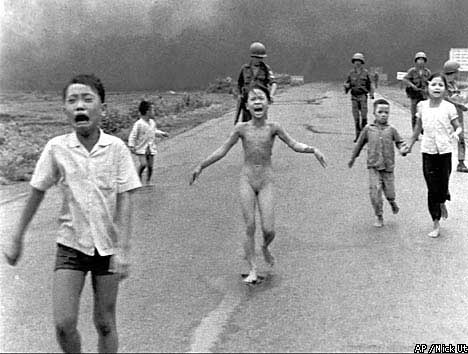
—Jonathan Schwarz
March 03, 2011
A Quick Joke
By: Aaron Datesman
It is possible, though unlikely, that you have not yet read this joke:
A unionized public employee, a member of the Tea Party, and a CEO are sitting at a table. In the middle of the table there is a plate with a dozen cookies on it. The CEO reaches across, takes 11 cookies, looks at the Tea Partier, and says, "Look out for that union guy, he wants a piece of your cookie."
Credit to Gar Lipow for making my life 320% more awesome.
— Aaron Datesman
Money & Power Score Again, Now Lead Politeness & Rationality 211,398,459-0
Last week I made another of my doomed attempts to use politeness and rationality to get people with power to correct false statements. In this case, I was trying to get Alec Ross, Hillary Clinton's "Senior Advisor for Innovation," to correct his claim on Washington, D.C.'s WAMU that Ray McGovern had been yelling at Clinton before he was dragged off and bloodied by security.
Here's what I did:
1. Politely addressed Alec Ross via twitter. No response.
2. Politely wrote to Alec Ross via Facebook. No response.
3. Politely called Alec Ross's assistant at the State Department, got her email address, and sent her the background. No response.
4. Politely sent a WAMU producer the background and politely followed up with a call. To the producer's credit, she told me they'd address this issue on their show this past Monday. I listened, but while I'd be happy to be corrected if I'm wrong, as far as I can tell they didn't (though they mentioned it without taking a position on their website). I politely sent another email asking what happened. No response.
I'm not sure why I find it so fascinating to prove over and over again that water is wet. I assume it's because I was taught for 17 years that water is dry, and I still can't get over it. Also, in this case I'm particularly affronted because Ray McGovern is not just an extremely knowledgeable and admirable person, he's a 71-year-old cancer survivor. Anyway, I guess everyone needs a hobby.
P.S. There was just some good news about this:
“The Constitution lives,” McGovern said after the government decided not to proceed with prosecution. “I am hugely grateful for the widespread condemnation of the brutal treatment I encountered two weeks ago for exercising my First Amendment rights. It strikes me as an empowering example of what we can do together in standing for justice and against the violence of war.”
I wonder if Alec Ross still believes the "cops did exactly what they ought to do."
—Jonathan Schwarz
Sorry!
General Petraeus is sorry about killing a bunch of children in Afghanistan:
PETRAEUS: We are deeply sorry for this tragedy and apologize to the members of the Afghan government, the people of Afghanistan and, most importantly, the surviving family members of those killed by our actions.
Likewise, Khalid Sheikh Mohammed is sorry about killing kids too:
KSM: Because war, for sure, there will be victims. When I said I’m not happy that 3,000 been killed in America. I feel sorry even. I don’t like to kill children and the kids. ... But there are exception of rule when you are killing people in Iraq. You said we have to do it. We don’t like Saddam. But this the way to deal with Saddam. Same thing you are saying. Same language you use, I use.
I've always liked this, from Stephen King's first novel, Carrie:
...sorry is the Kool-Aid of human emotions. It's what you say when you spill a cup of coffee or throw a gutterball when you're bowling with the girls in the league. True sorrow is as rare as true love.
—Jonathan Schwarz
March 02, 2011
Mad Town Solidarity and the Employee Free Choice Act
By: Aaron Datesman
It’s a few days old, but I found this to be hopeful:
Wausau Fire Department Lt. Steve Bahr, 54, said he came to Madison even though his benefits and bargaining rights aren't threatened."We have to keep trying to kill the bill and support the teachers," Bahr said, adding that many of his department's 50 union members had been coming Madison to demonstrate over the last week or so. "This is just the beginning. I know we're next."
I don’t remember how it goes, but first they came for the….came for….the….stayed for the cheese curds? Anyway. This post from Gin & Tacos says it really well, and I encourage you to read it.
For the most part, I don’t read the mainstream media, so I’m sure I just missed this speech on the front page of Sunday’s New York Times.
I’m Jeff Skiles. And two years ago I was being honored in this very Capitol building as a hero for being one of the pilots in the Miracle on the Hudson. But I’m here to tell you that on that day there were many, many heroes: pilots, flight attendants, air traffic controllers, firemen, policemen, crews of the ferry boats, EMTs. We didn’t abandon those passengers to save themselves; we all worked together to save everybody. That’s a lesson that people in this Capitol building need to learn. All those trained professionals put aside the fear for their own personal safety to get the job done. And every one of them was a union member. Unions help their people do their jobs better.And I’d like to talk to you today about one group that has touched my family’s lives. I’d like to talk about the educators in my home town of Oregon, Wisconsin, these professional men and women who have devoted their lives to develop and nurture our future, our children, and they have given my children and myself a priceless gift: I have watched my kids grow into responsible, intelligent and caring adults due to their contributions. Just yesterday, my youngest son, J.J., got his ACT college entrance exam scores in the mail. He got a 26. What do you suppose Scott Walker got? That’s a good enough score to get into Wisconsin’s flagship campus, here, the UW-Madison. But J.J. won’t be going to college next year, because J.J. is only in the eighth grade. That didn’t happen because of Scott Walker. That happened because of the educators in the Oregon School District, and that happened because of all of you.
But teachers are only one small collection of voices among the hundreds of thousands of nurses, public employees, state and local workers who will be impacted by this bill. Our federal government has acknowledged our basic right to join together and make our collective voices heard by union membership. The Supreme Court has defended that right. But this budget bill will strip Wisconsin public workers of the protections and rights enjoyed by other Americans. This bill will regulate public workers to second-class status in America. Are we going to let that happen?
Let’s not forget how this budget crisis came about, and let’s not let this governor and this Republican legislature shift the blame for what’s wrong with America from corporate profiteers and instead demonize our teachers, our nurses and our public-sector employees.
If you missed that episode of Democracy Now!, listen to it. It’s inspiring.
I honestly don’t know how the Wisconsin uprising will play out. At the moment, I’m cautiously optimistic that the protestors will accomplish their goals at the state level, for this year, or even for a few years into the future. The benefits in terms of education about labor issues, even on the national level, are undeniable. But I fear that the sacrifices which have been made in Madison will just represent a local victory in a war that has slowly been lost, all over the nation, for nearly my entire lifetime.
In the meantime, I suspect that it gets old sleeping on a cold stone floor, putting your life on hold for weeks, and submerging the self-doubt over whether the tough road is worth it. How to turn this around? I think that posting “Solidarity with the protestors in Madison” as my FaceBook profile update on Saturday probably does not have the man quaking in his boots, and is not truly inspiring even to friends I have in Madison. Is that all that Solidarity really means? What would tell the Madison protestors in a meaningful way that “WE ARE WITH YOU”?
In my opinion, the best approach is to expand the scope of the problem so that it touches all of us. That’s a useful meaning for the concept of Solidarity. Because Madison has given the labor movement some energy, we should make Madison about more than just Wisconsin.
We should use Madison to rally nationwide support for the Employee Free Choice Act. The attempt would probably not succeed (on the other hand, I wouldn’t mind coupling a government shutdown with a general strike), but I look into the future in this country and don’t see a better pro-labor teachable moment coming up anytime in my lifetime. Obama can hedge and not really do very much about the Madison protests because he's not the president of Wisconsin. EFCA would be a different matter for him.
(An added bonus is the positive gloss even the mainstream press has given to recent revolutions in the Middle East, which were powered in part by the labor movement. That's an advantageous confluence of events.)
— Aaron Datesman
The Lesson of the Drones
By: John Caruso
Here's former UN General Assembly President Miguel d’Escoto's rendition of a standard narrative of Obama admirers:
The United States is not what people think it is. I don’t think it’s what President Obama thought it was. I thought that being president—I think that he meant, really—I liked him. And I thank God for his coming to that high office in the United States, and I prayed that he would be elected. And I know that he was sincere. And in my waiting room, in my office at the United States, I had a great big picture of him, with—it’s like a poster with "hope" written underneath. And I wrote him a letter saying how much—how glad I was to hear him. But it has remained promises, because I think now he realizes that he is only the president in a country where the industrial-military complex decides what has to be done, and you cannot go beyond the parameters of what they decide. It would be dangerous.
The general version goes like this: Barack Obama is sincerely dedicated to progressive social change and earnestly wants to fulfill our every wish for a better society, but he's been thwarted by the powerful forces of a permanent government/corporate nexus that's beyond his control, and he's powerless to govern outside of their parameters (in some advanced versions of this fantasy he risks unspecified but presumably dire consequences unless he toes the line—"it would be dangerous", as d'Escoto says).
In this worldview, Obama is a pragmatic enemy of the forces of corporatism and militarism rather than a willing co-conspirator. He's our secret ally in the White House, chipping away from the inside when he can and making difficult compromises when he must. Much like God—in fact, exactly like God—he's never held responsible for even his worst crimes and betrayals. To take just one example, when the Obama administration kills hundreds of innocent people with drone strikes in Pakistan (and Afghanistan, and Yemen), it would be unfair to put any of the responsibility for this on Obama himself, because he effectively has no choice in the matter.
There's just one small problem with this worldview: objective reality. This was Obama in August of 2007, outlining his plans for Pakistan:
[L]et me make this clear. There are terrorists holed up in those mountains who murdered 3,000 Americans. They are plotting to strike again. It was a terrible mistake to fail to act when we had a chance to take out an al Qaeda leadership meeting in 2005. If we have actionable intelligence about high-value terrorist targets and President Musharraf won't act, we will. [...] I will provide our intelligence and law enforcement agencies with the tools they need to track and take out the terrorists without undermining our Constitution and our freedom.
Obama repeated this same intention throughout the campaign, as in his first debate with McCain in September 2008:
[W]e've got to deal with Pakistan, because al Qaeda and the Taliban have safe havens in Pakistan, across the border in the northwest regions, and although, you know, under George Bush, with the support of Senator McCain, we've been giving them $10 billion over the last seven years, they have not done what needs to be done to get rid of those safe havens. And until we do, Americans here at home are not going to be safe.
Obama actually outflanked McCain to the right on this, and McCain and other conservatives attacked him on multiple occasions for his irresponsibly hawkish rhetoric. It didn't make any difference, of course, and Obama easily won the presidency. And true to his word, one of his first acts as president was to launch drone strikes inside Pakistan—and he only accelerated the attacks from there:
The first drone strikes of the new presidency took place on Obama's third day in office - four Arabs, presumed to be al-Qaeda associates, died in a strike in the border region. But as many as 16 members of the extended family of a respected pro-government tribal elder died when the second drone strike that day went terribly awry.
A study by the New America Foundation last year found that just six of 41 CIA-launched drone attacks in the border region had targeted al-Qaeda members. Eighteen of the targets were Taliban and 16 of them alone were efforts to kill Baitullah Mehsud - which, depending on who did the counting, racked up more than 300 additional civilian deaths.
As that same article observed, "the professorial Obama is the new killer on the block, authorising more drone attacks in the first year of his term in office than Bush did in his entire presidency." And the new killer kept up the pace through his second year as well:
In the 21 months since his inauguration, President Obama has ordered or approved 120 drone attacks on Pakistan. There were 22 such attacks in September 2010 alone, reportedly killing more than 100 people. In contrast, Obama's predecessor Bush ordered just 60 attacks in eight years.
So to review: 1) in 2007 Obama announced his plan to launch attacks inside Pakistan; 2) he reiterated this intention throughout the campaign, going so far that he drew criticism from the right for his bellicose rhetoric; 3) after taking office he immediately started authorizing the very drone strikes he'd spent the past few years promising to carry out; and 4) his administration proceeded to launch more drone strikes in one year than George Bush had during his entire presidency, and Obama's total now stands at more than double Bush's.
Does this sound like a man who's acting against his will?
But the irrationality of Obama apologists doesn't end there. Consider just the last point above—that Obama launched more drone strikes in his first year in office than Bush did in eight years. To believe that this massive increase in the rate of drone attacks was not a direct result of Obama's policy, you have to believe either that 1) the military and intelligence services had wanted to ramp up the drone strikes for years, but were balked by well-known hippie peaceniks like George Bush and Dick Cheney who refused to go along with them, or 2) the fact that it started right as Obama became president was just a giant coincidence. Which just goes to show the depths of absurdity you can reach when your overriding goal is to explain away Democratic misdeeds.
The lesson of the drones is that Obama isn't a victim of powerful forces, but a willing ally. With few exceptions, he does what he does—from drone strikes to corporate tax cuts to whistleblower prosecutions—not because he has no choice, but because it's what he wants to do. And the lesson of those who refuse to learn the lesson of the drones is that partisanship trumps not just principle but common sense; to paraphrase Orwell, not only don't they disapprove of atrocities committed by their own side, but they have a remarkable capacity for not even seeing them.
— John Caruso
March 01, 2011
Spending? or Investing?
By: Aaron Datesman
One of the most interesting things I’ve learned in my current job is that, although the US government spends around $100 billion annually on scientific research, nobody can convincingly answer the following simple question: What’s the return on this investment? When scientists do hear this question, the approved response generally includes Tang, a few technical touchstones that most laymen have never thought about, and a reminder that science can make things blow up real good. And that’s kind of about been it.
This blew my mind when I first learned it, and I still find it incredible. So I think it’s positive that the government is busy building tools with which to answer this question. I was fortunate to witness this busy-ness firsthand at a workshop this past December.
In addition to a stunningly excellent set of remarks from Rep. Rush Holt (which are archived and which I will post), I learned a couple of very interesting things at the workshop. By far the most interesting thing I learned is discussed in this workshop paper from Prof. Julian Alston of UC-Davis.
Prof. Alston is an agricultural economist. I was surprised to learn that, compared to other areas of economics, technology, science, and policy, agricultural data is detailed, robust, and exhaustively studied. Therefore the results of Prof. Alston’s meta-study of Research, Development, and Extension investment in the agricultural sector has very significant implications for the value of research investment in other sectors as well. This is his conclusion (but I encourage you to read the whole thing – it’s not highly technical).
U.S. public agricultural R&D has earned very high returns, with benefit-cost ratios in the range of 20:1 and higher.
In plain terms, the benefits of $1 of government spending on agricultural R&D today are worth $20 in today’s money (the calculation refers to the net present value of future benefits which would accrue).
Remember this the next time you have a conversation with someone - and that somebody just might be a well-meaning liberal - who wants you to believe that the US government just has to cut spending.
— Aaron Datesman



